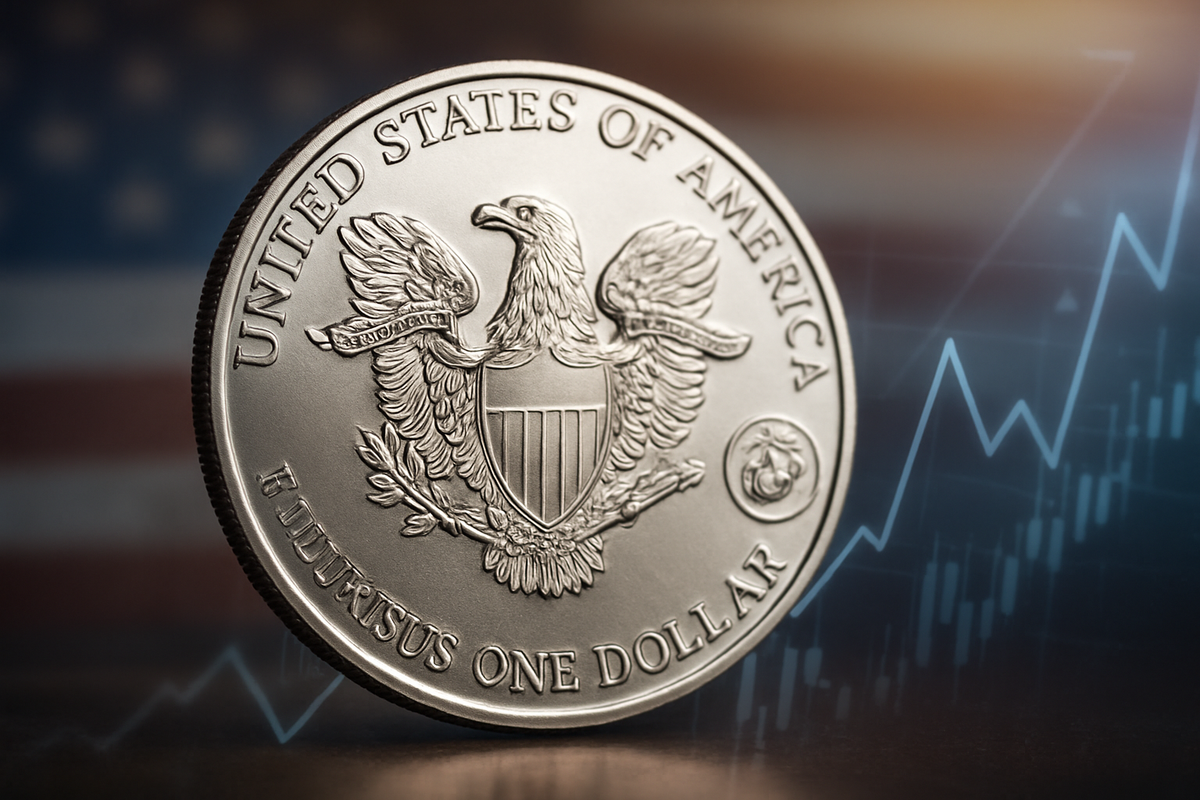
The market for commemorative silver coins is experiencing a significant surge, driven by a confluence of cultural pride, investment appeal, and robust global silver prices. A prime example is the highly anticipated 250th Anniversary United States Marine Corps American Eagle One Ounce Silver Proof Coin, slated for release in November 2025 with a special Marine Corps privy mark. These limited-edition releases, including similar privy-marked American Silver Eagles for the Army and Navy in 2025, are seeing intense demand, with the Army version reportedly selling out swiftly. This fervor is set against a backdrop of escalating silver spot prices, which have reached nominal all-time highs, hovering between $45 and $53 per ounce in October 2025. This price rally is propelled by strong industrial demand from sectors like solar energy and electric vehicles, coupled with increased investor interest seeking safe-haven assets amidst economic uncertainty and geopolitical tensions.
The immediate implications of this heightened demand are multifaceted. While commemorative coins represent a smaller segment compared to industrial or large-scale bullion investment, their popularity reinforces silver's appeal as a tangible asset and contributes to overall market interest. The rising cost of silver, however, is presenting challenges for mints. Germany, for instance, halted production of several commemorative silver coins in October 2025 because the intrinsic material value exceeded their face value, signaling potential financial viability issues for other national mints. Conversely, minting companies and distributors are benefiting from increased sales and the higher premiums these limited-edition coins command. This trend suggests a growing emphasis on the numismatic, artistic, and historical significance of these coins, moving beyond their raw metal content, as collectors and investors increasingly value rarity and cultural resonance as much as intrinsic silver value.
The Roar of the Eagle: A Deep Dive into Commemorative Silver's Ascent
The current surge in demand for commemorative silver coins is a meticulously crafted phenomenon, years in the making, culminating in a fervent collector's market in late 2025. At the heart of this excitement are the special privy-marked American Silver Eagle coins commemorating the 250th anniversaries of various branches of the U.S. military. The United States Mint (USM) has strategically planned these releases, with the Army 250th Anniversary American Silver Eagle already making headlines for its rapid sell-out, setting a precedent for the Marine Corps and Navy versions expected in November 2025. This carefully orchestrated timeline builds anticipation, turning each release into a significant event for numismatists and patriotic collectors alike.
The specific details driving this demand are rooted in both the intrinsic value of silver and the extrinsic appeal of limited-edition artistry and historical significance. The Marine Corps American Eagle, for example, is not just an ounce of silver; it's a tangible piece of history, adorned with a unique privy mark celebrating a quarter-millennium of service. These coins are typically struck in proof quality, showcasing frosted designs on mirror-like fields, further enhancing their aesthetic and collectible value. Key players involved include the United States Mint, responsible for the design, production, and distribution of these highly sought-after coins, along with authorized dealers and distributors who facilitate their reach to the public. Beyond the USM, private mints and grading services like Numismatic Guaranty Corporation (NGC) and Professional Coin Grading Service (PCGS) also play crucial roles, adding layers of authenticity and premium value through certification.
Initial market reactions have been nothing short of explosive. Reports of the Army 250th Anniversary American Silver Eagle selling out almost instantly upon release underscore the intense collector appetite. This immediate absorption of supply drives up secondary market premiums, with some uncirculated or graded examples fetching significantly more than their initial issue price. This phenomenon is not isolated to the U.S.; global precious metals markets are observing similar trends where limited-edition issues, especially those tied to significant cultural or historical events, command substantial premiums over their melt value. The confluence of rising silver spot prices—hovering between $45 and $53 per ounce in October 2025—and the inherent scarcity of these commemorative pieces creates a powerful upward pressure on their market value, making them attractive to both collectors and short-term investors.
The broader timeline leading to this moment includes a sustained period of elevated silver prices throughout 2024 and 2025, driven by industrial demand from green technologies and a flight to safe-haven assets. This high underlying value makes silver coins inherently more appealing. Simultaneously, a growing global interest in numismatics, particularly among younger demographics drawn to tangible assets and historical narratives, has expanded the collector base. The strategic marketing and limited mintage figures from national mints worldwide capitalize on this renewed interest, ensuring that each commemorative release becomes a highly anticipated event rather than just another coin launch.
Corporate Fortunes: Who Wins and Loses in the Silver Coin Boom
The escalating demand for commemorative silver coins, epitomized by the U.S. Marine Corps American Eagle, is creating a distinct stratification of winners and potential losers within the public market. This surge, fueled by both numismatic fervor and silver's intrinsic value, is impacting companies across the entire precious metals supply chain, from extraction to distribution and authentication.
The Beneficiaries: Mining, Refining, and Distribution Giants
At the forefront of the winning column are silver mining companies. As the underlying demand for silver strengthens—driven by both industrial applications and the collectible coin market—the price of the metal rises, directly boosting these companies' revenues and profit margins. Publicly traded entities such as First Majestic Silver (NYSE: AG), with its significant silver production and even its own minting facility (First Mint), stand to gain substantially. Similarly, Pan American Silver (NASDAQ: PAAS), a major primary silver producer, and Wheaton Precious Metals (NYSE: WPM), a streaming company that benefits from wider spreads as silver prices climb, are poised for increased profitability. Other notable primary silver producers like Hecla Mining (NYSE: HL), Endeavour Silver (TSX: EDR, NYSE: EXK), and MAG Silver (TSX: MAG, NYSEAMERICAN: MAG) are also experiencing tailwinds. Even Industrias Penoles (IPOAF), a diversified Mexican mining and refining company, benefits from both ends of the spectrum.
Beyond mining, silver refining companies are seeing increased throughput as more raw silver needs to be processed into high-purity bullion suitable for minting. This translates to higher revenues from refining fees. Furthermore, precious metals dealers and distributors are direct beneficiaries. Companies like A-Mark Precious Metals (NASDAQ: AMRK), a leading integrated precious metals platform, are experiencing robust sales volumes and higher premiums on popular items like commemorative coins. Their ability to manage inventory and expand e-commerce capabilities becomes crucial for capitalizing on this demand. The ecosystem also extends to coin grading and authentication services such as Professional Coin Grading Service (PCGS) and Numismatic Guaranty Corporation (NGC), which, while not always publicly traded standalone entities, are integral to the numismatic market's integrity. An increase in collectible coin demand directly translates to a higher volume of submissions for their value-adding services.
The Challengers: Industrial Users and Mints Under Pressure
Conversely, the same forces driving up silver prices for commemorative coins can create headwinds for other sectors. Industrial users of silver, particularly those in electronics, solar panel manufacturing, and electric vehicle components, face rising input costs. While silver's unique properties often make it irreplaceable in these applications, sustained high prices can squeeze profit margins for companies unable to fully pass on these increased costs to consumers. This can lead to a search for alternative, albeit often less efficient, materials or a reduction in profitability.
Even mints themselves can face challenges under specific conditions. While the United States Mint benefits from strong demand for its products, rapidly escalating silver prices can make the production of certain commemorative coins financially precarious. Germany's decision in October 2025 to halt the production of several commemorative silver coins because their material cost exceeded their face value serves as a stark warning. This scenario highlights a delicate balance: mints rely on premiums to cover production costs and generate profit, but if the underlying metal cost outpaces the collectible premium or face value, profitability can evaporate. The U.S. Mint has also historically faced capacity constraints in meeting surging bullion demand, which could limit its ability to fully capitalize on the current commemorative coin frenzy. Finally, jewelry manufacturers and retailers could also see profit margins erode if silver prices continue to climb, as silver is a primary raw material for their products.
Broader Horizons: The Wider Significance of Silver's Commemorative Craze
The burgeoning demand for commemorative silver coins, exemplified by the U.S. Marine Corps American Eagle, transcends mere collector enthusiasm; it reflects profound shifts in investment strategies, cultural appreciation, and the intricate dynamics of the global silver market. This phenomenon is a microcosm of larger trends, with ripple effects extending across industries, influencing policy, and echoing historical precedents.
A New Investment Paradigm and Expanding Market
One of the most significant broader trends is the re-emergence of collectible precious metal coins as a legitimate and increasingly attractive alternative asset class. In an era of economic uncertainty, inflation concerns, and volatile equity markets, investors are seeking tangible assets for wealth preservation and portfolio diversification. Silver coins, being more accessible than gold, act as a gateway for a broader demographic into the precious metals market. Projections indicate the global coin collection market, valued at an estimated $20.9 billion in 2024, could reach $47.5 billion by 2035, growing at a robust compound annual growth rate (CAGR) of 8.6%. This growth is not solely driven by intrinsic metal value; the numismatic value—rarity, historical importance, and unique designs—is playing an increasingly pivotal role, with commemorative design coins identified as the fastest-growing segment.
The ripple effects are widespread. National and private mints, while benefiting from higher sales and premiums, must navigate the delicate balance of supply and demand, as evidenced by Germany's recent halt in commemorative silver coin production due to soaring material costs. Precious metals refiners are seeing strengthened market positions due to the increased need for high-purity silver. Dealers, traders, and auction houses are experiencing a surge in transaction volumes, intensified by the proliferation of online platforms, which also fosters fierce competition. Furthermore, the rising value of these collectibles fuels demand for professional authentication and grading services, solidifying the roles of entities like PCGS and NGC in maintaining market trust and value. The industry is also witnessing partnerships with technology firms to leverage digital platforms and advanced authentication tools, including blockchain, to cater to a new generation of collectors.
Policy, Precedent, and the Dual Nature of Silver
Regulatory and policy implications are deeply embedded in the commemorative coin landscape. In the United States, commemorative coins are authorized by acts of Congress, serving not only to celebrate national heritage but also as a significant fundraising mechanism. Surcharges on these coins funnel millions of dollars towards specific causes, from museum construction to supporting Olympic programs. This highlights the government's strategic use of numismatic programs to achieve broader societal goals. However, legislative mandates also dictate production limits and design controls, ensuring exclusivity and managed scarcity, critical factors in maintaining collector interest and value. Taxation policies, such as Value Added Tax (VAT) on physical silver, can also significantly influence investor demand and market dynamics across different jurisdictions.
Historically, the demand for precious metals, including commemorative coins, has surged during periods of economic crisis and uncertainty. The 2008 financial crisis saw American Silver Eagles nearly double in value, and the COVID-19 pandemic reignited interest in collectibles as both a hobby and an investment. These precedents underscore silver's role as a safe-haven asset. However, history also offers cautionary tales; a glut of commemorative coins in the mid-220th century led to a hiatus in the U.S. program, with many coins being melted down due to lack of demand. This emphasizes the importance of carefully managed supply and perceived scarcity. Unlike gold, silver possesses a dual nature, with over 50% of its modern usage tied to industrial applications in clean energy, electronics, and health. This industrial demand provides a floor for silver prices, but also contributes to its higher volatility compared to gold, as it is influenced by both investment sentiment and global economic growth.
The Road Ahead: Navigating Silver's Shifting Sands
Looking ahead, the market for commemorative silver coins is poised for continued dynamism, driven by a complex interplay of economic forces, technological advancements, and evolving collector preferences. Both short-term opportunities and long-term challenges will shape the trajectory of this specialized yet influential segment of the precious metals market.
In the short term, the immediate outlook suggests sustained high demand for new, limited-edition releases, especially those with strong cultural or historical resonance like the military-themed American Eagles. Mints and authorized distributors will likely continue to capitalize on this fervor, potentially adjusting pricing strategies to reflect higher premiums. The robust silver spot price, currently between $45 and $53 per ounce in October 2025, provides a strong foundation for these coins, making them attractive to both collectors and short-term investors seeking quick gains on the secondary market. We can anticipate continued rapid sell-outs for popular issues and a vibrant secondary market for graded and certified examples.
For the long term, the future of commemorative silver coins will hinge on several factors. The sustainability of current silver prices, influenced by industrial demand from green technologies and ongoing geopolitical stability, will be crucial. If silver prices remain elevated, mints will need to strategically adapt their production models to avoid the financial viability issues faced by some European counterparts. This could involve higher issue prices, different metal compositions for certain coins, or a greater emphasis on numismatic value over intrinsic metal content. Strategic pivots will also be necessary for precious metals dealers, focusing on secure logistics, advanced e-commerce platforms, and diversified product offerings to maintain market share.
Market opportunities may emerge in the form of innovative product lines, perhaps integrating new security features or digital authentication methods like blockchain, to appeal to a tech-savvy generation of collectors. Collaborations between national mints and private entities to create unique, cross-cultural commemorative series could also expand the market. However, challenges include potential market saturation if too many commemorative issues are released, diluting their perceived scarcity and value. Regulatory bodies might also introduce new guidelines concerning mintage limits or sales practices to protect consumers and maintain market integrity.
Potential scenarios range from a continued bull run for silver, further elevating the value of these coins, to a more moderated market where numismatic appeal becomes the primary driver, decoupling value somewhat from the fluctuating spot price of silver. Another scenario could see increased competition from other tangible assets or even digital collectibles, requiring the silver coin market to innovate to retain its appeal. Ultimately, the market will demand a delicate balance between leveraging cultural significance, managing supply, and adapting to broader economic and technological shifts.
Final Thoughts: A Market Transformed and Enduring Allure
The current surge in demand for commemorative silver coins, particularly those honoring significant national events like the U.S. Marine Corps American Eagle, marks a transformative moment for the precious metals and numismatic markets. This isn't merely a fleeting trend but a reflection of deeper economic anxieties, a renewed appreciation for tangible assets, and the enduring power of historical and cultural narratives.
The key takeaway is that commemorative silver coins have cemented their dual identity: they are both a vehicle for investment and a cherished collectible. Their appeal is amplified by a high underlying silver price, driven by industrial demand from burgeoning green technologies and their traditional role as a safe haven. This confluence of factors creates a robust market where numismatic value often commands significant premiums over the intrinsic metal content. Public companies involved in silver mining, refining, and distribution are clear beneficiaries, experiencing heightened revenues and stock valuations. However, industrial users face increased input costs, and even mints must navigate the financial tightrope of soaring metal prices versus fixed face values.
Moving forward, the market will likely remain vibrant, characterized by strong demand for limited-edition releases and a dynamic secondary market. Investors should watch for sustained industrial demand for silver, global economic indicators that influence safe-haven appeal, and the strategic decisions of national mints regarding mintage figures and pricing. The increasing integration of technology for authentication and trading will also be a critical area to monitor. Ultimately, the lasting impact of this phenomenon will be the further legitimization of collectible silver coins as a distinct and valuable asset class, capable of weathering economic storms and celebrating enduring legacies. The allure of a beautifully crafted piece of history, imbued with both intrinsic value and cultural significance, continues to captivate, ensuring silver's place in portfolios and collections for years to come.
This content is intended for informational purposes only and is not financial advice






